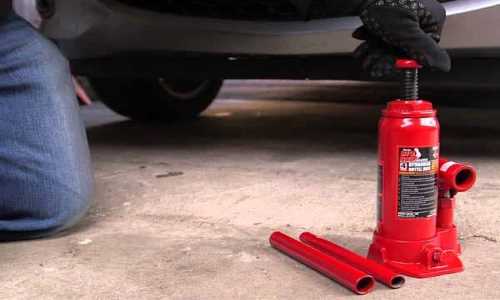How to choose the right hydraulic jack?
 By
By
Choosing the right hydraulic jack can be a daunting task, especially if you’re unfamiliar with all the types of jacks available on the market. This blog post will outline the different types of hydraulic jacks and help you choose the right one for your needs. We have you covered, from heavy-duty industrial jacks to portable models perfect for on-site use. So don’t miss out; read on to learn more about choosing the right hydraulic jack for your project. A hydraulic jack is a machine that uses hydraulics to lift and move heavy objects. This machine is used in various applications, such as construction, engineering, and manufacturing. There are a few things to consider when choosing the right hydraulic jack. First, consider the weight of the object you will be lifting. Second, determine the type of Jack you need. Third, determine the size of Jack you need. Fourth, consider the height of your work surface. Fifth, consider your budget. Finally, read the reviews before making your purchase! A hydraulic jack is a type of industrial machinery used to remove heavy objects from a position. It consists of a cylinder with pistons at the base and a hoisting arm that can be raised and lowered by hydraulic pressure. When the hydraulic pressure is released, the pistons drive the hoisting arm upward, which lifts the object off the ground. When choosing pancake hydraulic jacks, there are a few things to consider. The type of jack you need will depend on the size of the object you lift and the amount of pressure you require. There are three main types of hydraulic jacks: single-cylinder, double-cylinder, and triple-cylinder. Each has its advantages and disadvantages. Single-cylinder jacks are the smallest and lightest, but they have lower power ratings than double or triple cylinders. They are best for small objects that don't require much pressure, such as door hinges or window frames. Double-cylinder jacks have higher power ratings than single cylinders but are also heavier and more expensive. They are good for larger objects that need a lot of pressure, such as cabinet doors or roofing tiles. Triple-cylinder jacks offer the highest power ratings of all three types but also tend to be the most expensive. They're ideal for big objects that need lots of pressure, such as heavy furniture or walls. You'll want to look for a few things when choosing the right hydraulic jack. First, you'll need to determine what kind of lifting capacity you need. Second, you'll need to consider the weight of the object you'll be lifting and the type of ground your jack will be used on. Third, you'll need to decide on the size of the jack and whether or not it needs an arm or a handle. Fourth, ensure that the jack has oil and gas lubrication to operate smoothly. There are a few different types of hydraulic jacks on the market, each with its advantages and disadvantages. Here's a look at the different types of hydraulic jacks, their features, and how they work. Compound hydraulic jack: This type of jack comprises two cylinders that work together to lift weights. The advantage of this type of jack is that it can be used to lift heavier objects than other types of jacks. Piston hydraulic jack: This type of jack uses pistons to move the weight around. The advantage of this type of jack is that it is quieter than other jacks, making it good for use in noisy environments. Screw-driving hydraulic jack: This type of jack uses a screwdriver-like tool to drive the piston instead of a motor. The advantage of this type of jack is that it can be used in confined spaces where other jacks wouldn’t be able to fit. When shopping for a hydraulic jack, it is important to pay attention to the following factors: Capacity: Look for a jack with the capacity needed for the job. Weight: Keep in mind the weight of the object being lifted and select a jack accordingly. Construction: Make sure the jack is constructed from sturdy materials that will last. Safety features: Consider guard rails and automatic shutoff mechanisms to ensure safety when using the jack. Choosing the right hydraulic jack for your project can be a daunting task. There are so many different types and sizes to choose from, and it can be hard to know which is the best fit. Here are some tips on how to choose the right jack for your needs: First, decide what type of job you need the jack for. Are you installing a new roof? Repairing an old one? Raising or lowering something heavy? Knowing this will help you narrow down your selection a bit. Next, consider the weight of the object you're going to lift. A light object like a book might require a small jack, while something heavier like a tree might require a larger one. Finally, think about how much power you need. A Jack-Type Pneumatic (JTP) requires compressed air to work, while an Electric Jack requires electricity. If you don't have access to either type of jack, consider choosing an Oil-Lubricated Jack (OJ). These jacks use oil instead of air or electricity to move objects; they're good for lighter tasks that don't require too much power. When dealing with heavy equipment, hydraulic jacks are a must. But which one is right for you? In this article, we'll discuss the different types of hydraulic jacks and help you choose the one that's perfect for your needs. We'll also give you tips on how to use a hydraulic jack safely so that you can get the most out of it. So don't hesitate, to read on to learn everything you need to know about choosing the right hydraulic jack!What is a hydraulic jack?
How does a hydraulic jack work?
Types of hydraulic jacks
What to look for when choosing a hydraulic jack?
The Different Types of Hydraulic Jacks
What to look for in a hydraulic jack?
How to Choose the Right Jack for Your Project?
Conclusion






